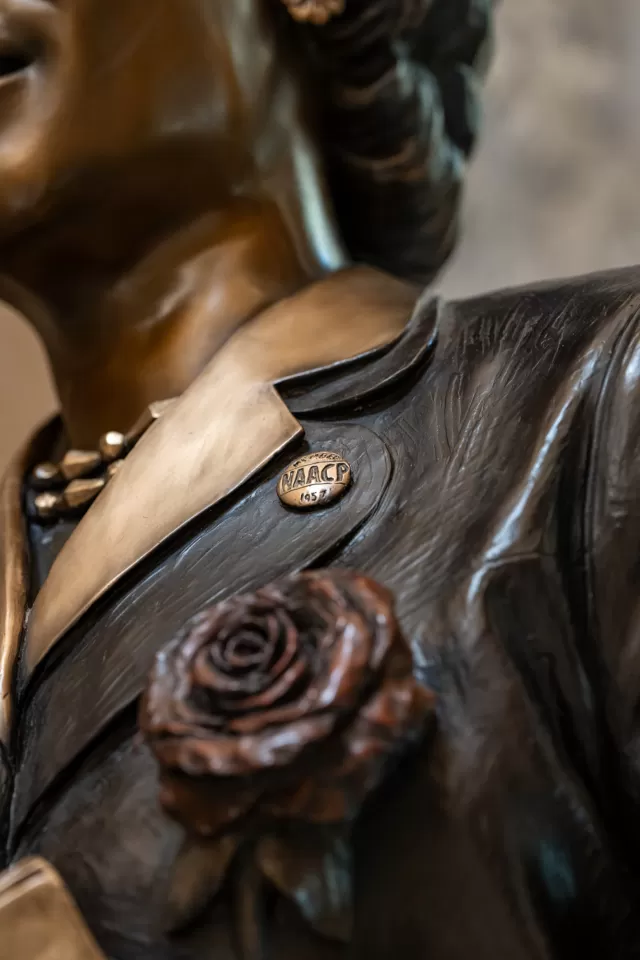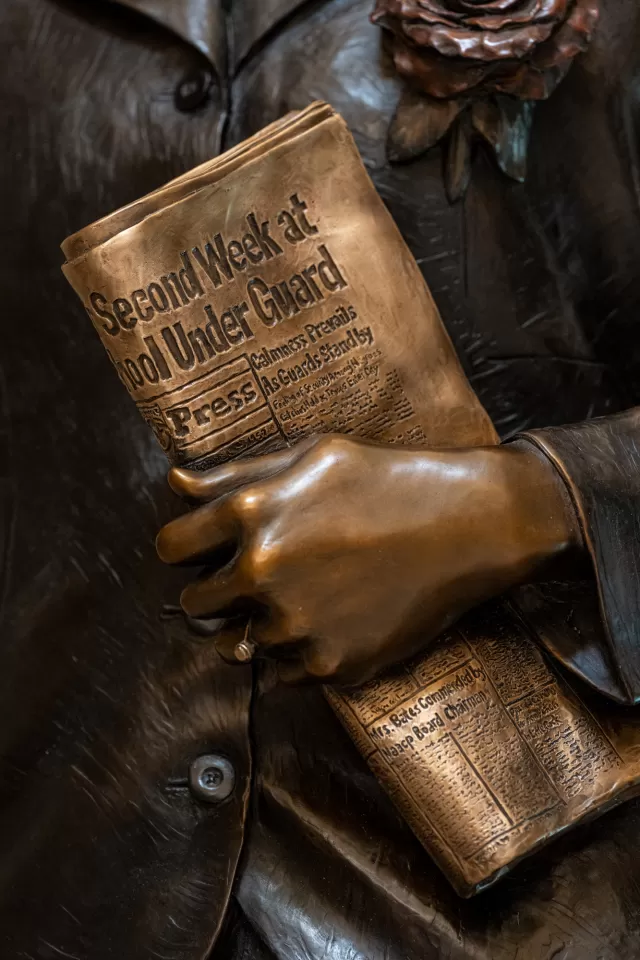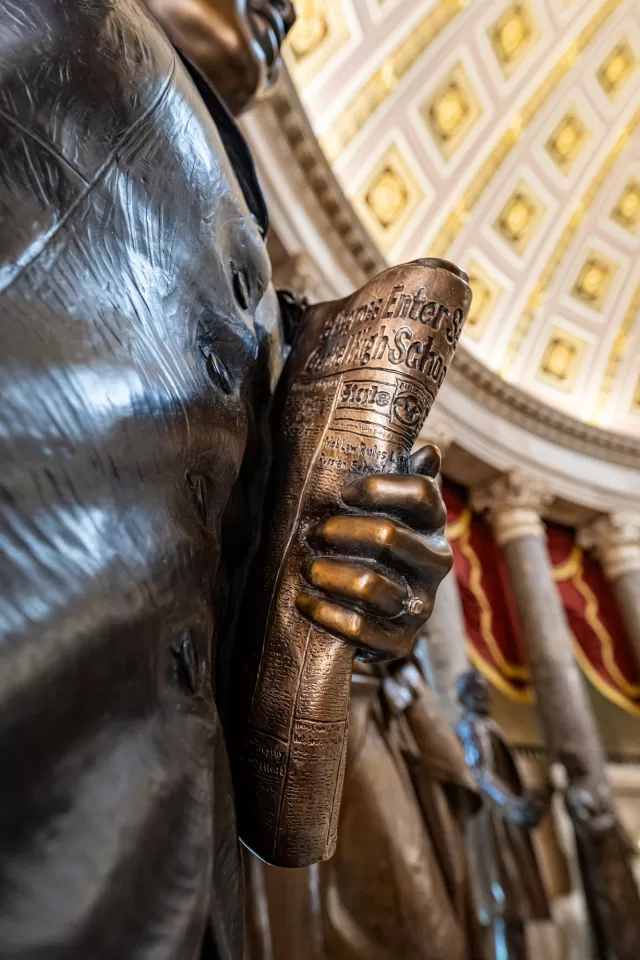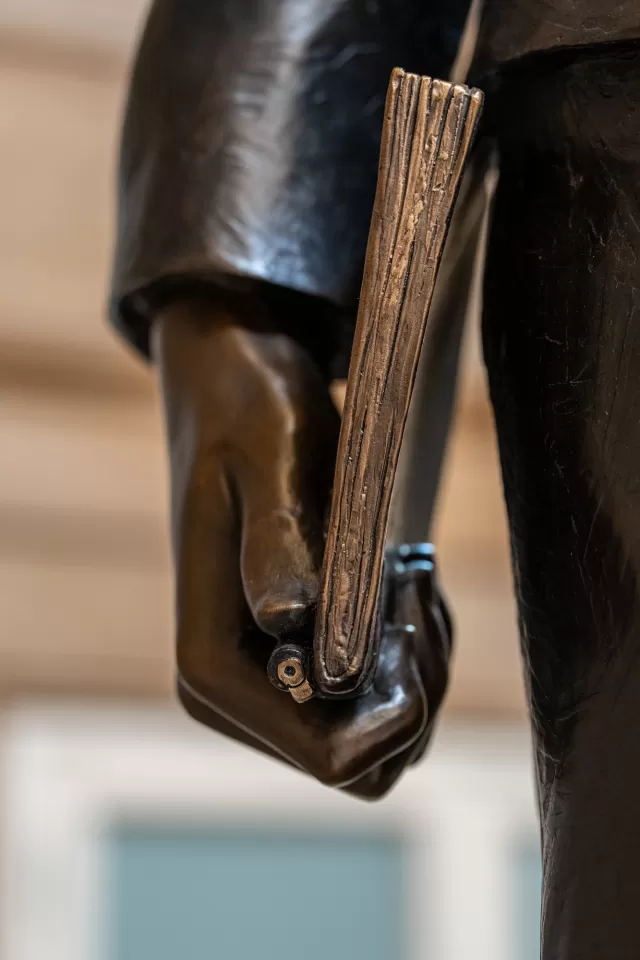Image Gallery





Arkansas gave this statue to the National Statuary Hall Collection in 2024. It is sculptor Benjamin Victor's fourth statue to enter the collection, the most of any living artist.
Artist Benjamin Victor focused this portrayal of Daisy Bates through the lens of her leadership. Based on both photographs and written descriptions of her in her forties, the depiction captures a composed and stylish Bates confidently striding forward with notebook and newspaper in hand. Her optimistic expression reflects her warmth, charm and unbroken calm. Victor was inspired to emphasize this optimism by the positivity that Bates expressed in her 1962 memoir.
Bates wears a dark suit with a button detail on the pockets and a lighter blouse with the collar layered over the suit lapels. Her impeccable appearance indicates both her personal style and her role as a leader in Little Rock's business community. She and her husband, L.C., published the Arkansas State Press, which focused on the African American community and consistently pressed for civil rights.
Bates had always paid attention to her appearance, and as she became more involved in activism, she used her beauty, femininity and "respectable" self-presentation to challenge prevailing stereotypes of African American women. Her personal style contributed to her dignified, almost regal, presence, matching her ability to remain cool under pressure. Friends recall her consistently wearing heeled shoes and polished ensembles. Her jewelry, including a wedding ring on her left hand, is based on pieces Bates wore in photographs. The earrings are daisies, which Victor employs as a reference to Bates's love of flowers and as a part of the artistic tradition of using flowers to indicate beauty, peace and love.
The pin on Bates's left lapel reads "NAACP/1957." Bates shared her husband's investment in the National Association for the Advancement of Colored People as a tool for fighting white supremacy and providing fairer opportunities for African Americans. It was Daisy, however, who took on the more public leadership roles. In 1952, she was elected president of the Arkansas State Conference of Branches, a position that placed her in the center of the NAACP's effort to desegregate Little Rock's schools. Bates served on the NAACP's national board from 1957 to 1970. During the 1960s, she worked on voter registration, mostly for the Democratic National Committee under Presidents John F. Kennedy and Lyndon B. Johnson. She also worked on anti-poverty programs, even moving to Mitchellville, Arkansas, for several years as part of her work to revitalize the town.
In her left hand, Bates holds a folded newspaper—a copy of the Arkansas State Press. L.C. had been a journalist much of his life, and the Bateses began the paper in 1941. Bates's involvement in the business increased over the years. She contributed mainly to management operations, but she also covered meetings and news, especially in later years. The paper closed in 1959, after advertising income and subscriptions declined because of the couple's support for school integration. Much later, after L.C.'s death, Bates started a new Arkansas State Press. She owned the paper from 1984 to 1988.
The headline on the October 4, 1957, newspaper, "9 Negroes Enter Second Week at Central High School Under Guard," directs viewers to the events that contributed most to Bates' fame. Both Bateses had been involved in NAACP actions seeking school desegregation following the 1954 and 1955 Supreme Court decisions in Brown v. Board of Education, and as school began in 1957, Daisy stepped fully into the role of spokesperson, liaison and lightning rod. A team of adults supported the nine African American students attending Central High School that year, not least the children's parents, but it was Bates who signed NAACP press releases; gave interviews to the press; connected the students to their lawyers, tutors, and to journalists; coordinated with the national NAACP office; and made speech after speech to regional and national audiences, raising funds and awareness each time she spoke. While she never had her own children, throughout her life Bates had cared for young people—sometimes fostering them in her home. Her connection to the Nine had some of those qualities, and her ability to convey their side of the desegregation story cultivated sympathy for the students. Her ability and willingness to be in the spotlight also made her a target; she and L.C., along with friends and paid guards, stood nightly watch over their home, enduring cross burnings on their lawn, rocks thrown through windows, and frequent threats of additional violence.
In her right hand, Bates holds a notebook and pen, another reference to her involvement in the Arkansas State Press. Bates also worked with ghostwriters to write a memoir, The Long Shadow of Little Rock, which was a key source for Victor. The flower on Bates's lapel was inspired by a passage in which Bates compares her growth to the blossoming of a rose. Varied organizations recognized her civil rights leadership in Little Rock, including the National Council of Negro Women (1957 Woman of the Year) and the Associated Press (1957 Woman of the Year in education and top ten newsmakers list). The NAACP awarded its prestigious Spingarn Medal in the Little Rock Nine and Bates in 1958. Bates was one of the few women who spoke at the 1963 March on Washington. Her willingness to push against boundaries and expectations, to ask for what was needed, and to tell the stories that illustrated the need for change all contribute to her image as an icon of the civil rights movement.
The statue was cast at Parks Bronze Foundry in Oregon and stands on a granite pedestal, with a total height of more than 10 and a half feet. On the front of the pedestal, the inscription provides an overview of Bates's life:
DAISY LEE GATSON BATES
1914-1999
ARKANSAS
CIVIL RIGHTS LEADER * JOURNALIST
AUTHOR * PUBLISHER
Champion of the integration of schools
Provided leadership for the Little Rock Nine
The sides of the pedestal are inscribed with quotations from Bates's writing. On the proper left side:
The organization that was the prime target
of all segregationists was the NAACP. The
record this organization wrote in the "Battle of
Little Rock" will stand as a monument to man's
eternal yearning for human rights and decency.
On the proper right side:
No man or woman who tries to pursue an ideal
in his or her own way is without enemies.
The statue of Bates was unveiled in National Statuary Hall on May 8, 2024.
Benjamin Victor (1979- ) initially learned about art from his grandmother, an art professor. He first tried sculpting at Northern State University in South Dakota and fell in love with working in three dimensions. He won his first large commissions when he was still in college, including his first sculpture for the National Statuary Hall Collection. His other works in the U.S. Capitol are: Sarah Winnemucca (Nevada, 2005), Norman Borlaug (Iowa, 2014) and Chief Standing Bear (Nebraska, 2019). While these statues are all bronzes, he also carves marble and trained with a Florentine master stone carver.
Victor has received national and international recognition, including several awards from the National Sculpture Society. He is artist-in-residence and professor of the practice at Boise State University in Idaho. Victor also maintains a studio where he can carve marble and execute many of the elements in the bronze casting process.
Victor works in both abstract and figurative styles. Even when creating a portrait sculpture, he prefers a conceptual approach, focusing on the spirit of the person and the reason the portrait was commissioned. He edits and refines a sculpture at each step of the modeling process.
For this statue of Bates, Victor consulted photographs and written descriptions, as well as Bates's own writing. He also spoke with people who knew Bates and captured their memories of her in the finished work. Working from a scanned copy of the Arkansas State Press, he hand-carved the newspaper headlines.




